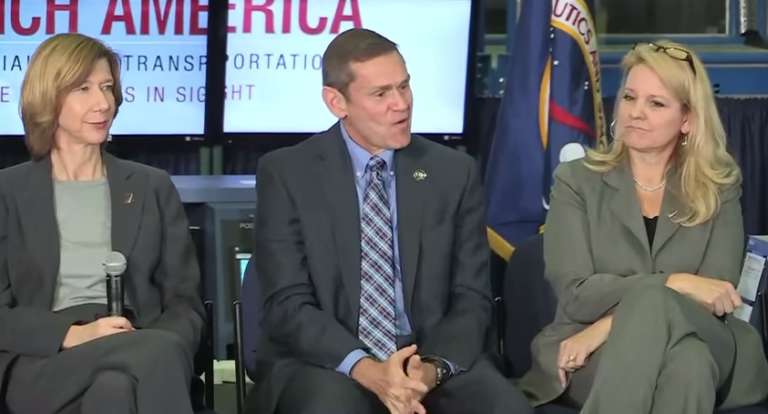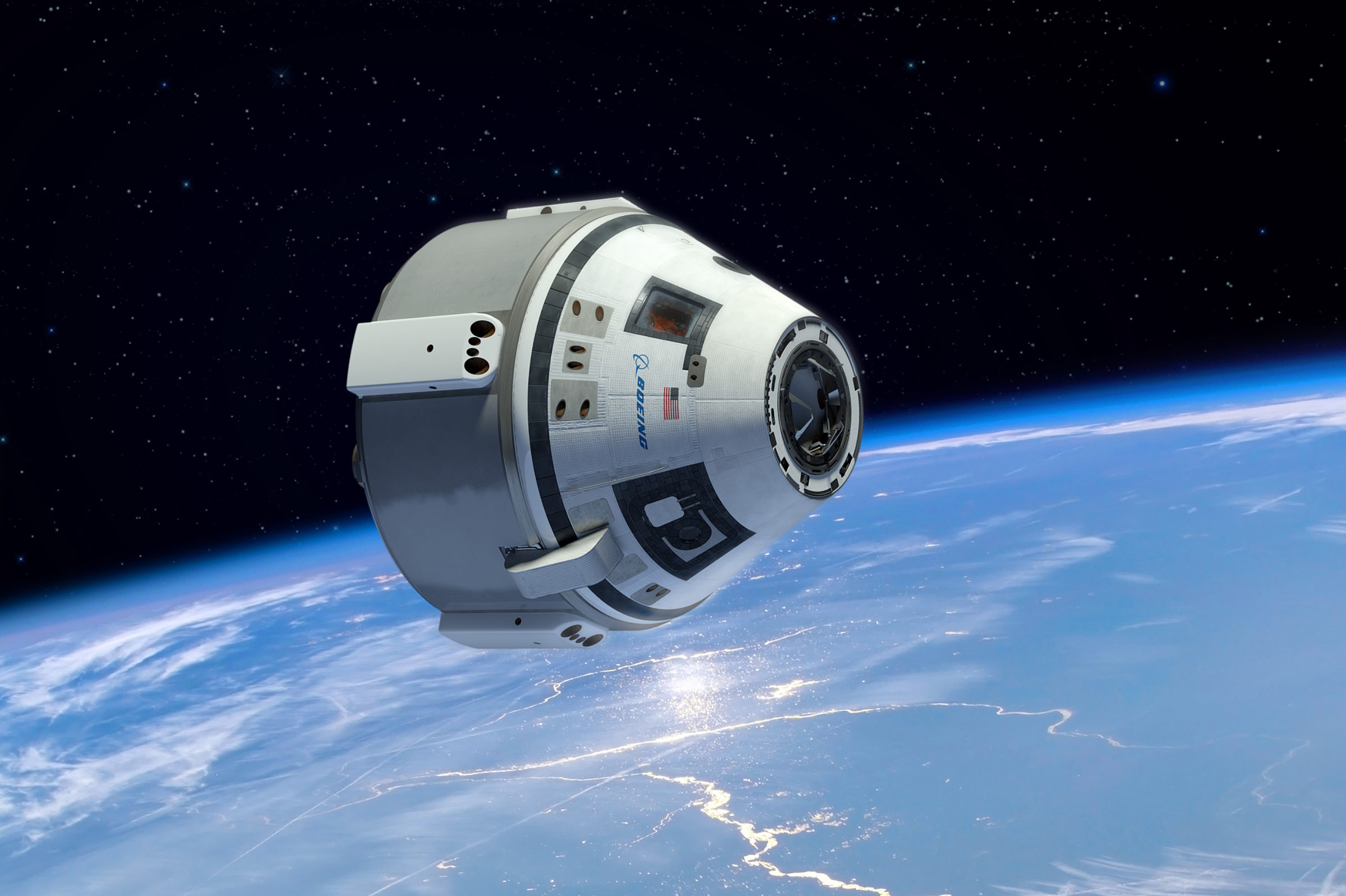Jason Davis • Jan 28, 2015
Commercial Crew Rivalries: Fun to Watch, Everybody Wins
Do you think John Elbon and Gwynne Shotwell are friends?
It's hard to say. Elbon is the vice president and general manager of Boeing's space exploration division. Shotwell is the president and chief operating officer of SpaceX. On Monday, the two rivals sat side-by-side at NASA's Johnson Space Center in Houston, talking with reporters about how their companies will bring International Space Station access back to American soil. Neither smiled much, but to be fair, stoic expressions are common at NASA press conferences.
At one point, Elbon and Shotwell were asked whether their per-astronaut price would be cheaper than Russia's—about $70 million. "Our pricing is not substantially different than our cargo program," replied Shotwell. That figure is currently about $133 million. Divide it by NASA's four-person crew requirement, and you get $33 million per seat. SpaceX says they can even fly five crewmembers and still carry the necessary amount of cargo, which could lower that number to $27 million.
Shotwell handed Elbon the microphone. What was Boeing's per-seat cost in comparison to the Russians? "Less than," Elbon simply said, with a smile.
A few audience members chuckled. Shotwell did not.

As the commercial space race heats up, exchanges like this are fascinating to watch. Until recently, SpaceX's struggle to shake up a long-established launch industry has largely played out behind the scenes. But now that Boeing and SpaceX have won the high-profile privilege of carrying astronauts to the station, they must—by necessity—start making appearances together as reluctant equals.
Boeing first, by necessity
To begin flying regular, paid crew missions to the ISS, Boeing and SpaceX must each complete two demonstration missions with their respective spacecraft, the CST-100 and Dragon Version 2. The first demo flights won't have crews. Even though SpaceX has already been flying Dragon cargo missions to the ISS since 2012, they still have to complete this step since the crewed Dragon variant has a different design. The second flights will carry astronauts. Exactly how many and what type—NASA or commercial—is still being decided.
After completing these two missions, SpaceX and Boeing will be eligible for paid crew flights. NASA's current contract gives each company between two and six missions. While we don't know which company will be the first to reach this milestone, we do know that Boeing will likely receive the first "Authority To Proceed"—NASA-speak for a green light to schedule the mission.
"The first mission that we will be looking at ATPing right now a Boeing mission, just because of the differences in lead time," said Kathy Lueders, NASA's Commercial Commercial program manager. Boeing's CST-100 launches atop the Atlas V, a rocket used heavily by the Air Force and NASA for a variety of missions. Flying on the Atlas V means booking a launch slot far in advance. As such, Boeing may get a paperwork thumbs-up before SpaceX does.
By contrast, SpaceX's Falcon 9 rocket schedule is already weighted toward NASA cargo missions. That is beginning to change, however, as the company lands more non-ISS contracts. Soon, SpaceX intends to have a second launch pad up and running at the space shuttle's old stomping ground—Launch Complex 39A. There, the company intends to begin flying its new triple-core rocket, the Falcon Heavy.
SpaceX Falcon Heavy flight animation Video: SpaceX
Boeing is aware of their impending bottleneck, and may soon begin work on a new launch vehicle for the CST-100. In a document outlining the reasons for selecting Boeing and SpaceX as commercial crew providers, William Gerstenmaier, NASA's associate administrator for human spaceflight, had this to say:
"I also recognized that Boeing proposed to pursue an alternate launch vehicle in parallel with their baseline design work. This new launch vehicle, if used in the CTS design, provides alternatives but would negate the benefits of the established reliability of the existing launch vehicle."
In other words, a new Boeing rocket would be nice, but it would initially be a riskier choice given the reliability of the stalwart Atlas V.
The battle for hearts and minds
Beyond the technological battle, a second competition is being waged on the public relations front. This is an arena in which SpaceX has traditionally dominated, with slick graphics, a strong social media presence, and a charismatic CEO, Elon Musk. Two weeks ago, SpaceX tried to land the spent core stage of a Falcon 9 rocket on a floating landing pad in the Atlantic Ocean. Information about the attempt, which was "close, but no cigar," came exclusively from Elon Musk on Twitter. Then, SpaceX released a short video of the crash using Vine, a looping video service.
The response from the space reporting community was largely positive—a testament to SpaceX's public relations strategy (if they have one). First, there was the content of the video itself. Spectacular rocket crashes—providing no one was hurt—are a fascinating spectacle. Especially for those of us who spent the occasional childhood afternoon blowing up crab apples with firecrackers. Secondly, distributing a looping Vine video on social media was more hip than sending out a dry press release with vague descriptions. Musk poked fun at the latter approach by calling the rocket crash a "Rapid Unscheduled Disassembly," or RUD. Finally, by releasing footage of the incident and describing what happened on Twitter, Musk and SpaceX projected an impression of transparency.
The only downside is that SpaceX is not required to do any of these things. Thus far, Musk has served as a benevolent dictator when it comes to information about his rockets. But the flow of information could stop at any time. SpaceX could become the next Blue Origin, and space reporters would have little recourse. We can only hope that SpaceX and other companies continue to see the value of being transparent—or at least, appearing that way.
This social media approach has caught the attention of at least one other rocket CEO, Tory Bruno. Bruno heads up United Launch Alliance, the joint Boeing-Lockheed Martin venture responsible for the nation's Atlas and Delta rocket fleets. Bruno recently joined Twitter. His tweets are surprisingly candid, and he is an unabashed promoter of his company. And, like most of us, he gets pretty excited about rockets. He recently celebrated an Atlas V launch with a hearty "WOOHOO."
Bruno also spars regularly with a parody account, and has even tweeted directly to Elon Musk. After this tweet, one could be forgiven for thinking Bruno was trolling:
@elonmusk @TrampolinRocket Almost. Good luck next time. I still have people from DCX. Let me know if we can help pic.twitter.com/cRLK0W0pwP
— Tory Bruno (@torybruno) January 16, 2015When rocket providers compete, you win
According to NASA's commercial crew source selection document, the three competing companies—SpaceX, Boeing and Sierra Nevada—were graded according to three factors: price, mission suitability, and past performance. Price accounted for half of each company's score. The other half was split between mission suitability and past performance, with mission suitability receiving a slightly higher weight.
SpaceX was the winner on price, but Boeing won on both mission suitability and past performance. So, while SpaceX has been able to consistently undercut its competitors on taxpayer dollars, they may have room to grow elsewhere. In the end, the two companies might learn from one another. If SpaceX keeps growing its reputation as an affordable, reliable ride to space, they will continue to gain market share. And as a result, companies like Boeing will have no choice but to adapt and innovate.
When NASA regains the capability to launch astronauts to the ISS from the Florida coast, the agency says it can double the amount of time dedicated to pure research in low-Earth orbit. And that, said Administrator Charles Bolden, puts humans one step closer to moving beyond Earth orbit. "All of this we're doing," he said, "will enable us to eventually get humans to Mars."



 Explore Worlds
Explore Worlds Find Life
Find Life Defend Earth
Defend Earth

